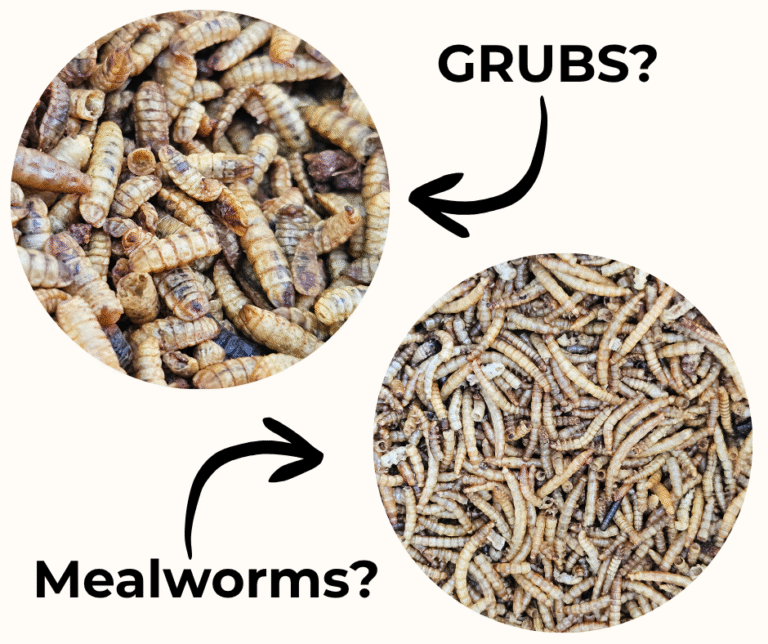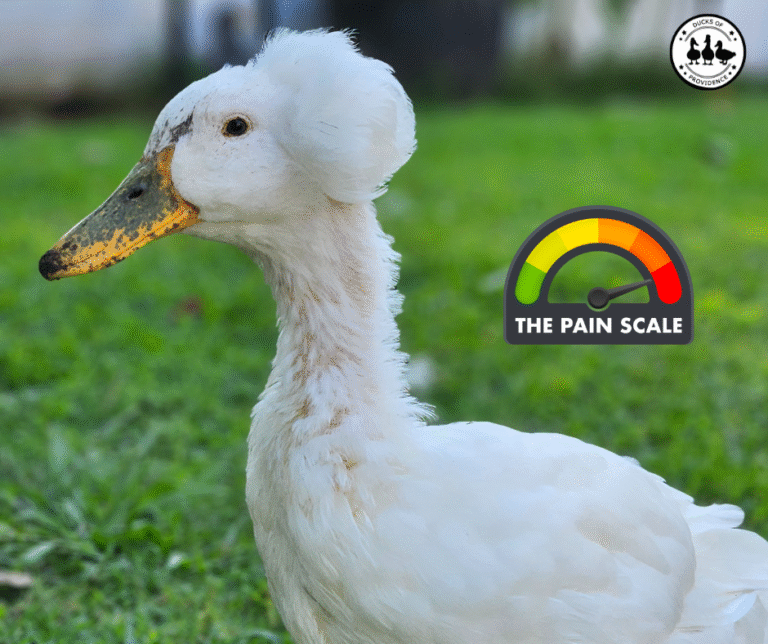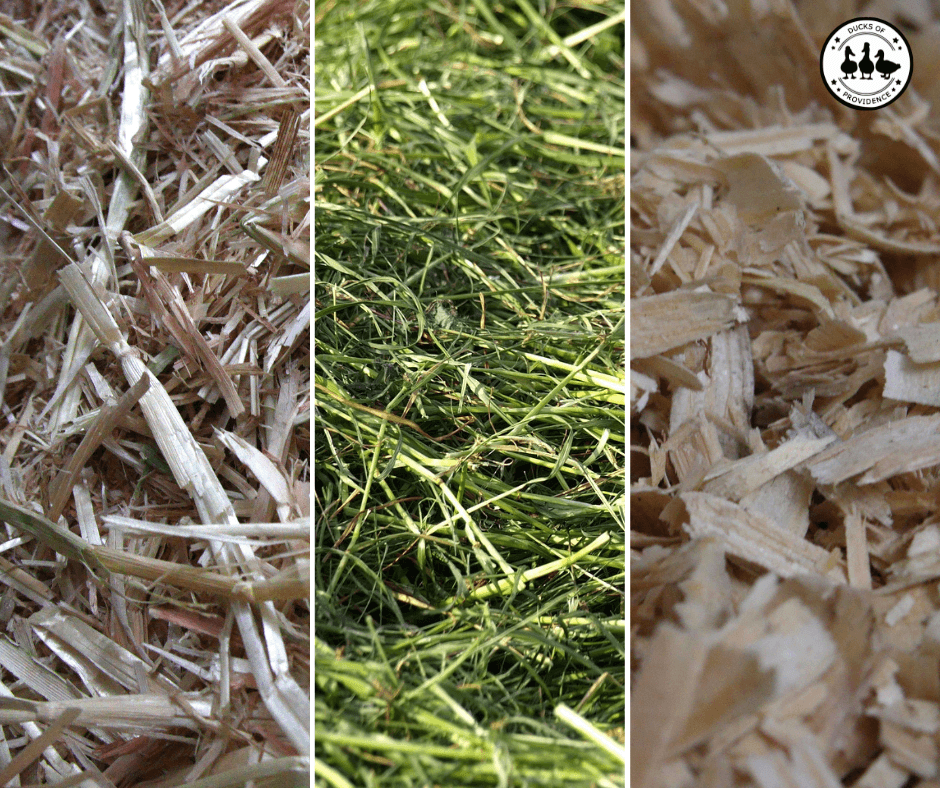
What is the Best Bedding for Ducks?
Last updated on February 9th, 2025 at 03:35 pm
When it comes to caring for your ducks, providing the right bedding is one of the most important decisions you’ll make. Ducks are naturally messy creatures, often splashing water around and creating wet, muddy areas in their living space. This makes choosing a bedding material that’s absorbent, comfortable, and easy to clean essential for keeping their environment healthy and hygienic.
With so many bedding options available—each with its pros and cons—it can be tricky to know what’s best for your flock. In this guide, we’ll dive into the most commonly used bedding materials, from straw and pine shavings to more unconventional options like hemp and pellet bedding. We’ll also discuss the bedding types that are best avoided, highlighting potential health risks and common pitfalls.
By understanding the characteristics of each option, you can create a safe, dry, and cozy living space for your feathered friends. Let’s explore which bedding materials will work best for your ducks!
Disclaimer: I may earn a commission if you buy products or services through my affiliate links. This will not affect the price you pay. I only recommend products or services that I believe will be beneficial to my readers.
Straw As Bedding For Ducks
Straw is one of the most traditional and widely used bedding materials for ducks. It’s a natural option that offers several benefits, though it also comes with a few challenges. Let’s take a more in-depth look at the pros, cons, and best practices for using straw as bedding for your ducks.
What is Straw?
Straw is the dried stalks of cereal crops, typically leftover from harvesting grains like wheat, barley, or oats. It’s hollow, which helps trap heat, making it a great insulator, especially in colder weather. Straw is not to be confused with hay, which is cut earlier and contains more nutritional value, as it is meant to be fed to animals, while straw is primarily used as bedding.
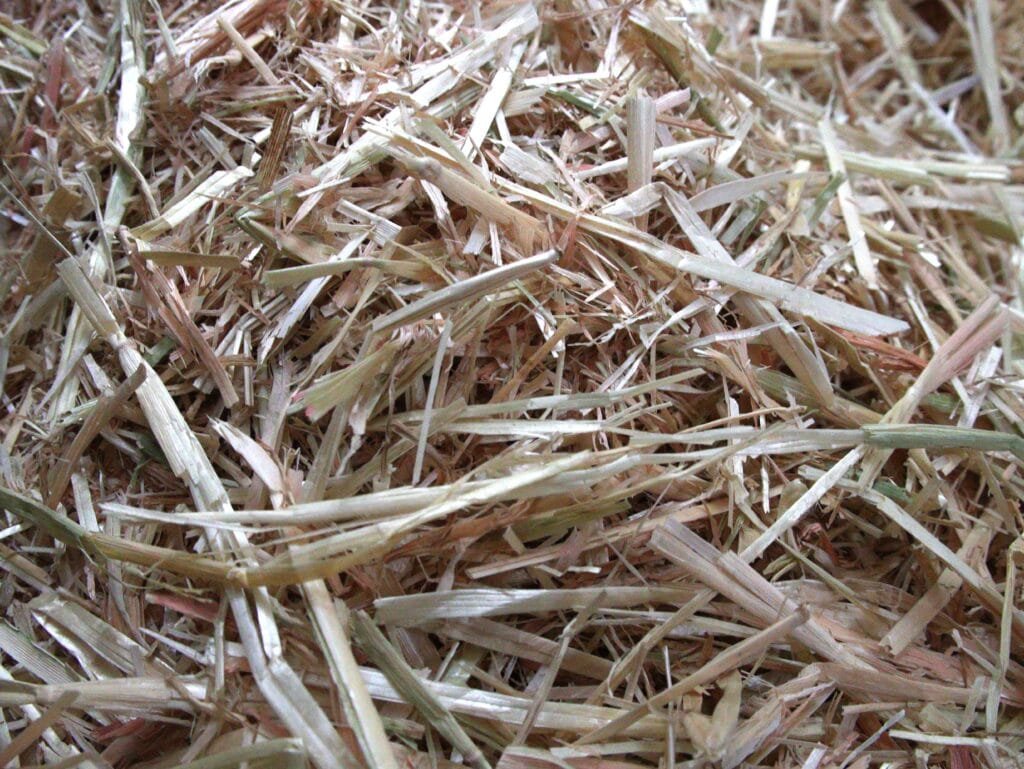
Pros of Using Straw for Duck Bedding
- Affordable and Easily Available:
- Straw is one of the most cost-effective bedding options. It’s usually easy to find at local feed stores, garden centers, or even farms. You can often buy it in large bales, making it economical, especially if you have a large flock.
- Good Insulation:
- Straw is excellent at trapping warmth, which can be a major advantage in colder climates or during the winter months. Ducks, especially when they are brooding or during the night, benefit from a warm, dry nesting area, and straw does a great job at providing this.
- Soft and Comfortable:
- Straw is relatively soft, providing a cushioned surface that helps protect ducks’ feet and joints. Ducks, especially heavier breeds like Muscovies, benefit from softer surfaces that reduce pressure on their feet, lowering the risk of issues like bumblefoot.
- Natural and Compostable:
- Being an organic material, straw is fully biodegradable and can be composted after use. It breaks down into a rich material that can be added to a garden or compost pile, making it a sustainable bedding choice.
- Ideal for Nesting:
- Straw is often preferred for nesting boxes because ducks love to burrow into it to make cozy nests. The hollow nature of straw helps create a snug environment for broody ducks or for those laying eggs.

Cons of Using Straw for Duck Bedding
- Poor Absorbency:
- One of the biggest downsides to straw is that it isn’t very absorbent. Once it gets wet, it tends to hold onto moisture rather than drying out quickly. This can lead to damp conditions, which are not ideal for ducks, as it can cause mold, bacterial growth, and lead to respiratory or foot issues.
- Mold Risk:
- Because straw is organic and doesn’t absorb moisture well, it can easily become moldy if it gets wet and isn’t changed frequently. Mold spores can be harmful to ducks, particularly if they breathe them in. Regular cleaning and ensuring the straw stays dry is crucial to prevent this problem.
- Needs Frequent Changing:
- Since straw can become soiled and soggy relatively quickly, you’ll need to replace it frequently to keep the duck house clean and dry. If left too long, wet straw can become a breeding ground for bacteria and parasites, which could compromise your ducks’ health.
- Can Get Messy:
- Ducks are naturally messy with water, and straw tends to clump together when wet, which can create a soggy, compacted mess that is more challenging to clean out. Regular maintenance is necessary to keep the bedding dry and fluffy.

Best Practices for Using Straw
If you decide to use straw as bedding for your ducks, here are some tips to get the most out of it while keeping your ducks healthy and happy:
- Keep it Dry:
- Ducks love water, and their bedding can get soaked easily, especially near water sources like bowls or pools. Position waterers outside of the duck house or use splash guards to help minimize water contact with the straw. In outdoor runs, consider using other materials like gravel or sand near water sources to absorb water.
- Frequent Cleaning:
- Make sure to remove soiled straw regularly—ideally daily if it gets very wet—to prevent moisture buildup. A deep bedding method (where you add new straw on top of old straw) can work temporarily, but this requires a complete clean-out every few weeks to avoid mold.
- Provide Proper Ventilation:
- Proper airflow in the duck house is important to reduce moisture buildup and odors. Well-ventilated spaces help keep straw dry for longer and reduce the risk of mold and bacterial growth.
- Use it in Combination:
- Many duck owners combine straw with other bedding materials to mitigate its cons. For example, using a base layer of pine shavings underneath straw can help absorb moisture and keep the area drier while still providing warmth and softness.
- Composting:
- After cleaning out your duck house, add the used straw to your compost pile. Over time, it will break down into rich compost that you can use in your garden, giving your duck’s bedding a second life!

When Straw is the Best Option
Straw is particularly useful in these scenarios:
- Cold Weather: Straw’s insulating properties make it ideal for colder climates where keeping your ducks warm is a priority.
- Nesting Boxes: Ducks enjoy making nests in straw because it’s easy for them to manipulate into comfy shapes.
- Dry Conditions: If you live in a dry climate or have a well-drained duck house, straw might work well, as it won’t get as soggy or moldy compared to wetter environments.
Final Thoughts on Straw
Straw can be a great bedding option if you’re looking for something cost-effective, warm, and comfortable for your ducks, especially in colder weather or for nesting areas. However, its poor absorbency means it requires more maintenance to keep clean and dry, which is something to keep in mind if you live in a wet or humid environment. For many duck owners, a combination of straw with a more absorbent material, like pine shavings, offers the best of both worlds—comfort and moisture control.
If you’re already using straw, have you had any issues with wetness, or do you combine it with other materials?
Pine Shavings As Bedding For Ducks
Pine shavings are one of the most popular bedding choices for ducks, offering a good balance of affordability, absorbency, and comfort. While they aren’t perfect for every situation, pine shavings tend to work well in both indoor duck houses and outdoor runs. Let’s dive deeper into the benefits and drawbacks of using pine shavings as bedding, along with best practices to maximize their effectiveness.
What Are Pine Shavings?
Pine shavings are small, thin pieces of wood that are typically a byproduct of sawmills. They are available in various sizes, with finer shavings being more absorbent, and larger shavings providing more cushioning and air circulation. Pine shavings are often compressed into bales or bags and are widely available at pet stores, farm supply stores, and even online.
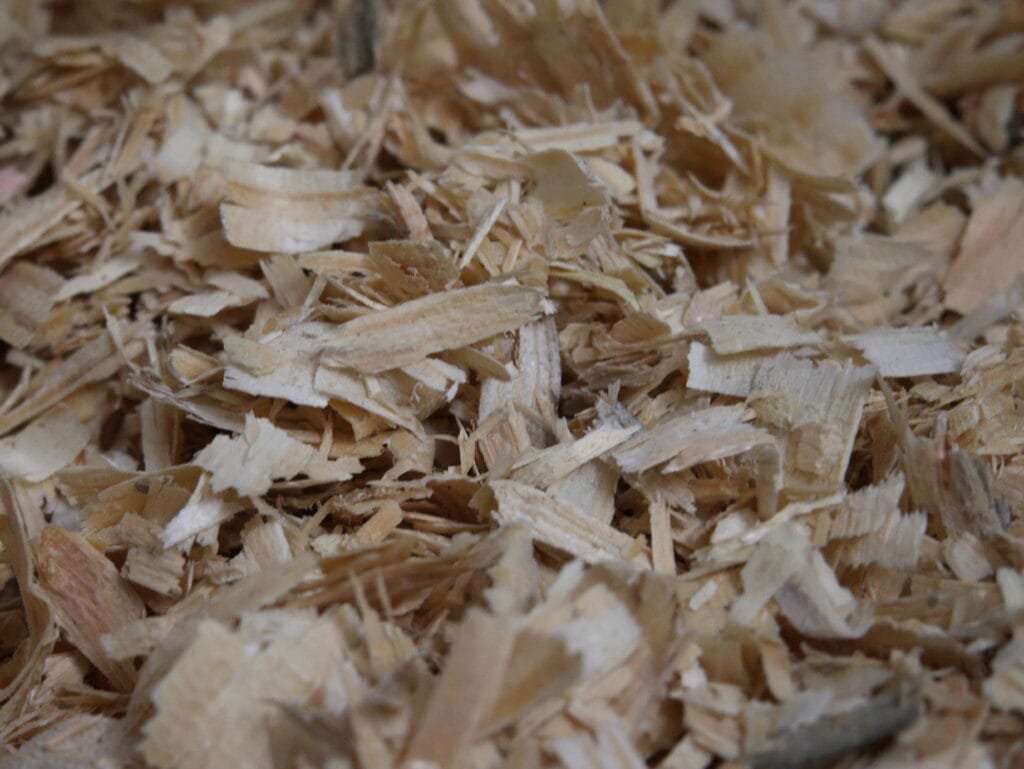
Pros of Using Pine Shavings for Duck Bedding
- Highly Absorbent:
- One of the biggest advantages of pine shavings is their high absorbency. They soak up moisture well, which helps keep the bedding dry and reduces the risk of mold, bacterial growth, or wet conditions that could lead to health problems like bumblefoot or respiratory issues.
- Good Odor Control:
- Pine naturally helps to neutralize odors, especially compared to straw or hay. This means your duck house will stay smelling fresher for longer, which is especially beneficial if you’re keeping ducks in a more enclosed space.
- Soft and Comfortable:
- Pine shavings provide a soft, cushiony surface, which is particularly good for ducks’ feet. Since ducks can be prone to foot problems like bumblefoot if they stand on hard surfaces for extended periods, the softness of pine shavings helps protect their feet and joints.
- Low Dust:
- While not completely dust-free, pine shavings tend to have less dust compared to other types of wood shavings (like cedar) or straw. Less dust means healthier air quality for your ducks, especially in enclosed spaces where poor ventilation could cause respiratory issues.
- Readily Available and Affordable:
- Pine shavings are widely available and fairly inexpensive, making them a convenient choice for many duck keepers. You can usually find them in different bag sizes, allowing you to buy in bulk and save money over time.
- Easy to Clean:
- Pine shavings are relatively easy to clean. Since they don’t clump together when wet, you can quickly spot-clean areas that have become soiled by simply removing the wet bedding and replacing it with fresh shavings. This makes day-to-day maintenance easier and less time-consuming.
- Compostable:
- Like straw, pine shavings are biodegradable and can be added to your compost pile once they’ve been used. They break down relatively quickly, turning into a rich, carbon-rich material that’s great for gardens.
- Non-Toxic:
- When using kiln-dried pine shavings, there’s no need to worry about toxic chemicals or fumes. Kiln-drying ensures that harmful oils in the wood are reduced, making the bedding safe for your ducks.
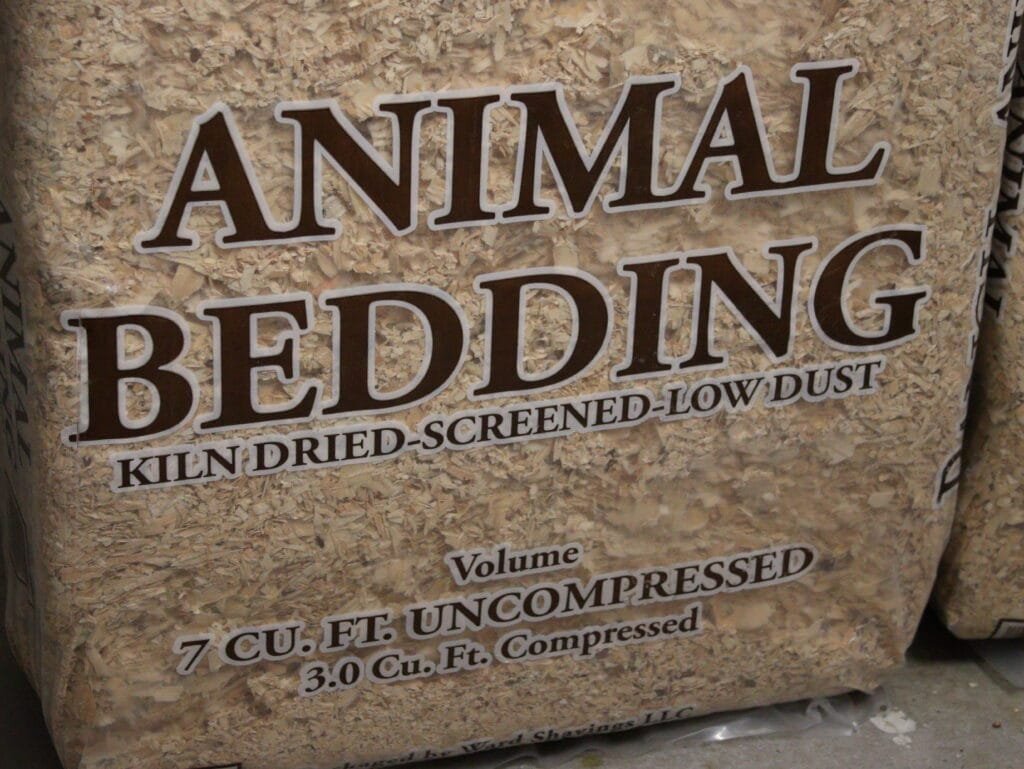
Cons of Using Pine Shavings for Duck Bedding
- Not Ideal for Wet Environments:
- While pine shavings are absorbent, they can still become saturated quickly if your ducks are excessively messy with water. Once the shavings get wet, they can break down and become soggy, which can lead to an unpleasant odor and potential mold growth if not cleaned out promptly.
- Can Be Costly Over Time:
- Even though pine shavings are generally affordable, you may need to replace them more often in wet or heavily used areas. Over time, the cost of frequently replenishing the bedding may add up, particularly if you have a large flock of ducks.
- Potential for Mold:
- Like any organic material, pine shavings can become moldy if they stay wet for too long. This can be a concern in damp climates or in duck houses where moisture is an issue. Regular cleaning and proper ventilation are essential to prevent mold from forming.
- Not Fully Dust-Free:
- Although pine shavings have lower dust levels than some other options, they are not completely dust-free. If your duck house is enclosed and not well-ventilated, dust from the shavings could still be a minor issue, especially for ducks with respiratory sensitivities.
- Risk of Pine Oils:
- If the shavings are not kiln-dried, the natural oils in pine can be harmful to ducks. These oils, when heated or broken down, may release fumes that could irritate the respiratory system. Therefore, it’s crucial to use kiln-dried pine shavings to avoid this issue.
Best Practices for Using Pine Shavings
To make the most of pine shavings in your duck house or run, consider the following tips and best practices:
- Keep Water Outside or Elevated:
- Ducks love to play in water, and they’re bound to splash it around. Try to keep water sources outside the duck house to prevent the shavings from getting wet, or elevate water bowls using platforms or bricks so that the bedding doesn’t soak up as much water.
- Frequent Spot-Cleaning:
- Regularly spot-cleaning wet or soiled areas of the shavings will help maintain a dry and healthy environment. You don’t need to replace all the shavings at once—just remove the dirty parts and top up with fresh shavings where needed.
- Deep Bedding Method:
- For those who want to reduce cleaning frequency, the deep bedding method works well with pine shavings. This method involves adding fresh layers of shavings on top of old ones over time, allowing the lower layers to slowly compost. This approach can provide additional insulation in colder months, though you’ll need to do a complete clean-out every few weeks to prevent any mold or bacteria buildup.
- Ensure Proper Ventilation:
- Proper ventilation is essential to prevent moisture buildup, odors, and dust accumulation in your duck house. This is especially important when using pine shavings, as good airflow helps keep the bedding dry and extends its lifespan.
- Composting Used Shavings:
- Once the pine shavings are soiled and removed, they make an excellent addition to your compost pile. Pine shavings, combined with the nitrogen-rich duck manure, create a balanced compost that can later be used in gardens.
- Check for Kiln-Dried Shavings:
- Always opt for kiln-dried pine shavings to avoid potential problems with natural oils in the wood. These oils are significantly reduced through the drying process, making the shavings safer for your ducks.

When Pine Shavings are the Best Option
Pine shavings are an excellent choice in many situations, but they are particularly useful in:
- Indoor Duck Houses: Since pine shavings offer a good balance of absorbency and odor control, they are ideal for indoor spaces where moisture levels are more controlled.
- Dry Climates: If you live in a region where humidity or frequent rain isn’t a concern, pine shavings can work well in outdoor runs or houses, keeping ducks’ feet comfortable and dry.
- Smaller Flocks: With a smaller flock, you may find that pine shavings are easier to manage and less expensive, as they won’t need to be replaced as frequently.
Final Thoughts on Pine Shavings
Overall, pine shavings are one of the best bedding materials for ducks due to their absorbency, odor control, and comfort. They’re easy to find, affordable, and can be used in various environments with proper care. However, you’ll need to keep an eye on moisture levels and clean out any wet or soiled bedding to prevent odors and mold from forming. For duck owners who prioritize comfort, cleanliness, and affordability, pine shavings are a solid choice.
Do you already use pine shavings for your ducks, or are you thinking about giving them a try? If you’re combining them with other bedding materials, I’d love to hear how that’s working for you!
Hay As Bedding for Ducks
Hay is another bedding option that duck owners might consider, though it’s not as commonly used as pine shavings or straw. While it offers some unique benefits, hay also comes with specific challenges that you’ll need to manage carefully if you choose to use it in your duck house or run. In this detailed breakdown, I’ll cover everything you need to know about using hay as bedding for ducks—the good, the bad, and how to make the most of it.
What Is Hay?
Hay refers to cut and dried grass or legumes like alfalfa, usually harvested and stored for animal feed. It’s typically coarser and more fibrous than straw, with more nutritional content because it still retains the leaves and stems of the plants. While hay is commonly used to feed livestock such as horses, goats, and cattle, it can also serve as bedding material for ducks in certain situations.

Pros of Using Hay for Duck Bedding
- Natural and Soft:
- One of the primary benefits of using hay is its natural, soft texture. Ducks love to nestle in it, making it a comfortable option for bedding, especially in nesting boxes where ducks lay their eggs.
- Provides Insulation:
- Hay can offer excellent insulation in colder months. Its dense nature traps heat well, helping to keep your ducks warm, especially if you live in an area with cold winters. This makes hay a solid option for bedding during fall and winter.
- Absorbs Moisture to Some Degree:
- Although hay isn’t as absorbent as pine shavings or straw, it does have some capacity to soak up moisture, especially in its early stages of use. It can help keep the duck house relatively dry, though you’ll need to replace it more frequently once it starts to get damp.
- Readily Available:
- If you’re in a rural area or near farms, hay can often be sourced easily, either in large bales or smaller bundles. It’s a common and widely available material, making it an accessible choice for bedding, particularly if you’re already using it to feed other livestock.
- Biodegradable and Compostable:
- Like straw and pine shavings, hay is fully biodegradable, which makes it a great option for composting. Once it has been used as bedding, it can be added to your compost pile, where it will break down and contribute to a rich, organic material that’s ideal for gardening.
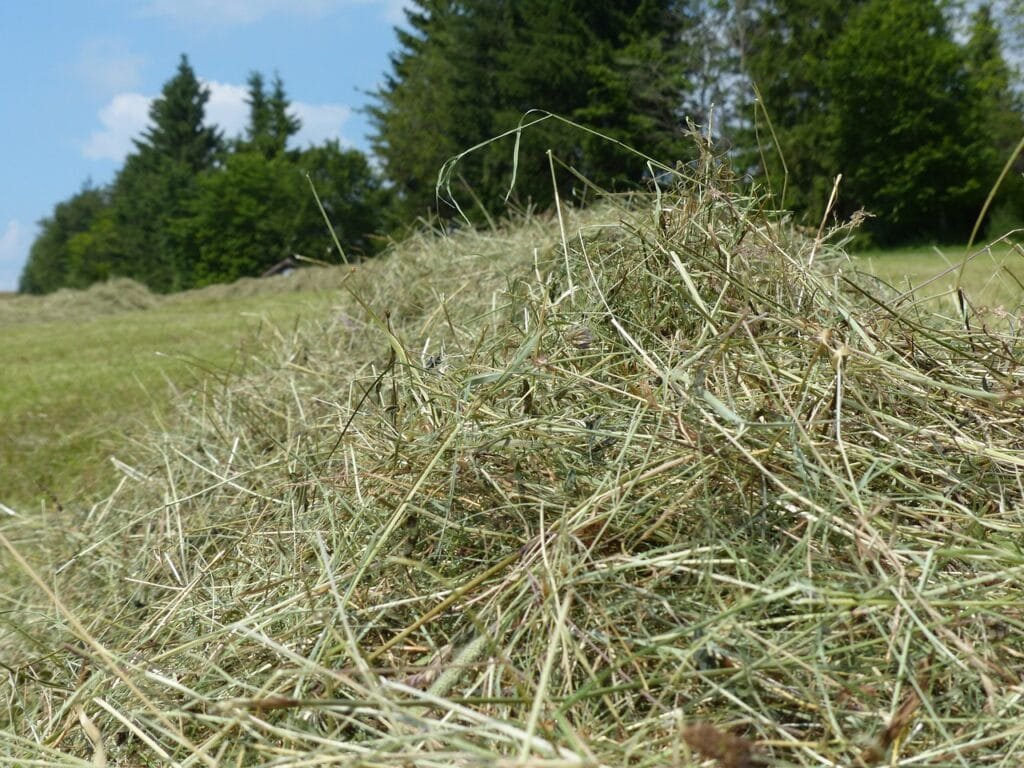
Cons of Using Hay for Duck Bedding
- Prone to Mold:
- One of the biggest downsides of using hay is its tendency to become moldy when exposed to moisture. Hay retains more moisture than straw or pine shavings, and once it gets wet, it becomes a perfect breeding ground for mold and mildew. This is a major concern, as mold can lead to serious respiratory problems in ducks and other health issues.
- Not Very Absorbent:
- While hay can absorb some moisture, it isn’t as absorbent as pine shavings or straw. If your ducks have access to water inside their house or are very messy with their water, the hay can become soggy and break down quickly, creating a damp and unsanitary environment.
- Can Be Expensive:
- Hay tends to be more expensive than straw or pine shavings, especially if you’re not buying it in bulk. Depending on the size of your flock and how frequently you need to replace the bedding, the cost of hay can add up over time, making it a less economical option for larger duck flocks.
- Attracts Pests:
- Because hay is a food source for many animals, it can attract pests such as rodents and insects. Mice, rats, and other small creatures may be drawn to the hay in your duck house, particularly in colder months when they’re looking for both food and shelter. This can lead to problems with contamination and sanitation, as well as stress for your ducks.
- Heavier and Harder to Manage:
- Compared to pine shavings or straw, hay is denser and heavier. This makes it more difficult to spread around and clean up, especially if it becomes damp or soiled. Its heavier weight also makes it harder to remove and replace in large amounts, adding to the labor involved in regular duck house maintenance.
- Decomposes Quickly:
- Hay tends to break down faster than other bedding materials due to its plant-based composition. This means it won’t last as long as pine shavings or straw before it needs to be replaced. While it’s compostable, the frequent need for replacement means more work and cost over time.
Best Practices for Using Hay as Bedding
If you decide to use hay for your ducks, here are some tips to ensure that it’s used effectively:
- Keep Water Outside:
- Since hay is prone to becoming soggy and moldy, it’s important to minimize the amount of water that comes into contact with it. Try to keep water sources outside of the duck house or elevate water bowls to prevent spills. Ducks are notorious for splashing and making a mess with their water, so controlling the moisture is key when using hay.
- Change Bedding Frequently:
- Hay needs to be changed more often than other bedding materials because it can become damp and start to break down more quickly. Spot-clean wet areas daily, and replace all the bedding at least once a week to prevent mold and bacteria from developing. In wetter environments, you might need to change it even more often.
- Use Hay in Dry Climates:
- Hay performs better in dry climates where there’s less moisture to begin with. If you live in a region with high humidity or frequent rain, hay might not be the best option for you, as it can lead to faster decomposition and a higher risk of mold.
- Combine with Other Bedding:
- Some duck owners find success by using hay in combination with other bedding materials. For example, you could use hay in nesting areas and straw or pine shavings in the rest of the duck house. This way, you get the softness and warmth of hay where it’s needed most, while still benefiting from the absorbency and mold resistance of other materials.
- Ensure Proper Ventilation:
- Good ventilation is crucial when using hay to prevent moisture buildup and mold growth. Make sure your duck house has adequate airflow to keep the hay dry and to prevent the air from becoming too humid. Ducks are hardy, but they need fresh air to stay healthy.
- Consider Using Hay Only in Nesting Boxes:
- If you like the idea of using hay but are concerned about the moisture and mold issues, consider limiting its use to nesting boxes. Hay’s soft texture makes it ideal for creating cozy nests where ducks can lay their eggs, while using other materials like straw or pine shavings for the rest of the house can provide better moisture control.
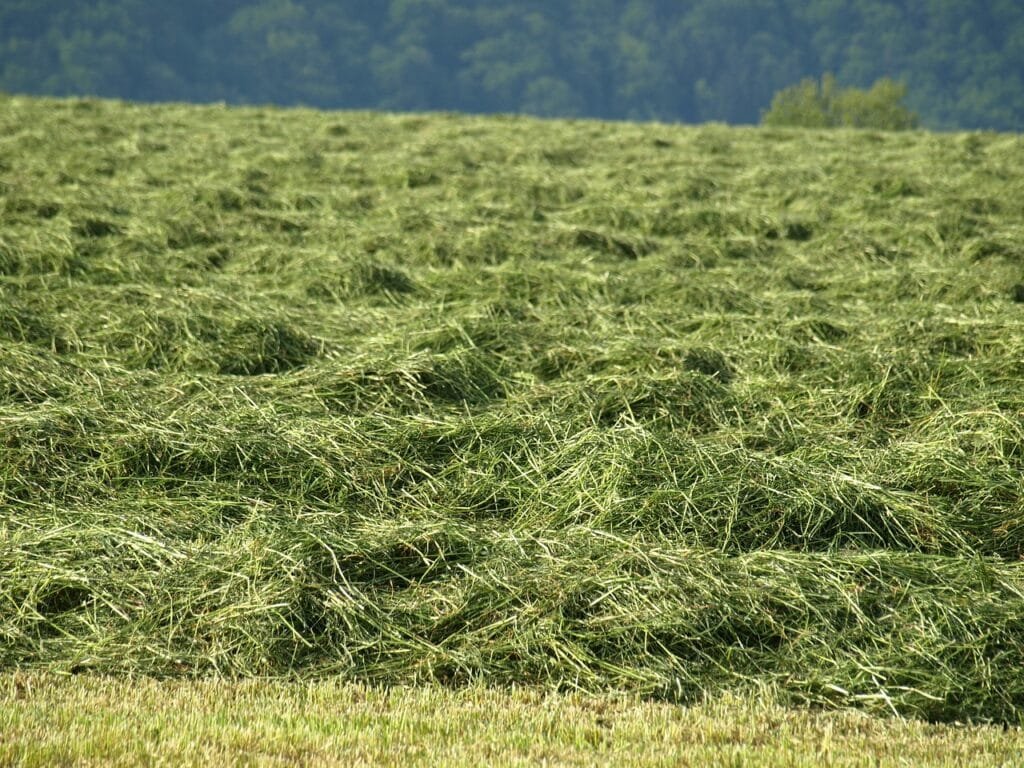
When Hay is the Best Option
Hay is particularly useful in certain situations, but it may not be the best overall bedding option for every duck keeper. Here are a few cases where hay can be a good fit:
- Nesting Material: Hay’s softness makes it ideal for nesting boxes, where ducks can comfortably lay eggs.
- Cold Climates: If you’re looking for a bedding material that provides insulation during the colder months, hay is a great choice for helping to keep your ducks warm.
- Limited Water Exposure: In environments where moisture can be kept to a minimum, such as in well-ventilated houses with water sources outside, hay can work well without becoming too soggy or moldy.
Final Thoughts on Hay as Duck Bedding
Hay can be a good option for specific uses, like nesting material or extra insulation in colder months, but it has its downsides. Its tendency to mold when wet, combined with its relatively low absorbency and higher cost, makes it less ideal as a primary bedding material, especially if your ducks have access to water in their house. However, if you’re careful about moisture control and regular cleaning, hay can provide a comfortable and natural bedding option for your ducks.
Have you ever used hay for your ducks? If so, how has it worked out for you? Or are you considering trying it now, perhaps for their nesting boxes? I’d love to hear about your experience or help you weigh your options!
Hemp Bedding for Ducks
Hemp bedding has gained popularity in recent years among duck and poultry keepers due to its impressive absorbency, sustainability, and other unique benefits. While it’s not as commonly known as straw or pine shavings, hemp offers some exciting advantages that make it a strong contender for duck bedding. Here’s an in-depth look at hemp as a bedding material, covering its pros, cons, and best practices for use.
What Is Hemp Bedding?
Hemp bedding is made from the stalks of the industrial hemp plant, which are processed and chopped into a soft, fibrous material. Unlike straw, which comes from the stalks of cereal grains, hemp bedding is denser and finer, often resembling soft wood chips or shavings. It’s natural, biodegradable, and highly absorbent, making it an excellent option for duck bedding.

Pros of Using Hemp for Duck Bedding
- Highly Absorbent:
- One of hemp’s standout qualities is its high absorbency. It can soak up moisture far more efficiently than traditional bedding materials like straw or pine shavings. Hemp is often touted to absorb up to four times its weight in liquid, which is a huge plus when dealing with ducks that love to splash water around and create a wet environment. This helps keep the duck house drier for longer periods and reduces the frequency of cleanings.
- Low Dust:
- Hemp bedding is extremely low in dust compared to other bedding materials like pine shavings or straw. This is particularly important for ducks, as excessive dust can cause respiratory issues. Low-dust bedding also makes the environment more pleasant for you when you’re cleaning or tending to the duck house.
- Highly Sustainable:
- Hemp is one of the most sustainable bedding options available. Industrial hemp grows quickly, requires fewer pesticides and water compared to other crops, and regenerates soil health. It’s an eco-friendly choice for duck keepers who are looking to minimize their environmental impact.
- Excellent Odor Control:
- Thanks to its high absorbency and natural properties, hemp bedding excels at controlling odors in the duck house. It traps moisture and ammonia more effectively than straw or pine, helping to keep the air fresher. This is particularly important for indoor setups or enclosed duck houses where ventilation might be limited.
- Soft and Comfortable:
- Hemp bedding is softer than straw and provides a comfortable surface for ducks to walk, rest, and nest on. Its fine texture makes it easy for ducks to nestle into, providing a cozy environment that reduces the risk of foot injuries, like bumblefoot, which can sometimes occur with harder bedding materials like straw or pebbles.
- Long-Lasting:
- Because hemp is so absorbent, it lasts longer between cleanings compared to other bedding types. Duck keepers report that hemp can often go several weeks or more without needing to be fully replaced, which saves on bedding costs and maintenance time. Spot cleaning is often enough to keep the bedding fresh for extended periods.
- Lightweight:
- Hemp bedding is lightweight, making it easy to spread, clean, and replace. Unlike heavier materials like hay or straw, hemp is simple to manage, even in large duck houses or runs.
- Compostable:
- Hemp bedding is fully biodegradable and breaks down quickly in compost. It’s a great addition to your compost pile, adding organic material that enriches the soil. Hemp is also known to decompose faster than straw, contributing to healthier compost in less time.
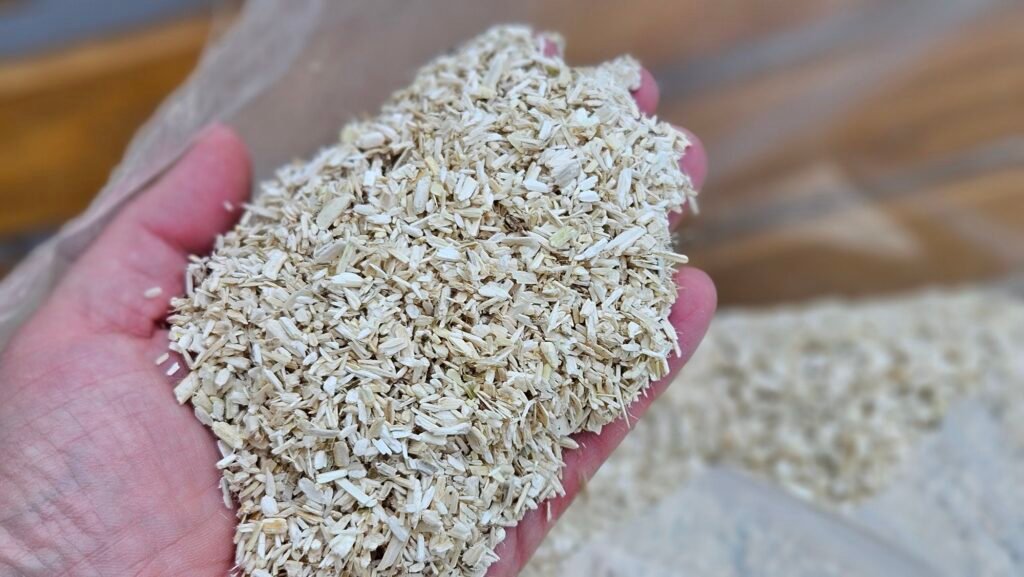
Cons of Using Hemp for Duck Bedding
- Cost:
- One of the main downsides of hemp bedding is its cost. Hemp is typically more expensive than straw or pine shavings, especially if it’s not locally available and needs to be shipped. The higher upfront cost can be a barrier for some duck owners, particularly those with large flocks that require a lot of bedding.
- Not as Readily Available:
- Can Be Slippery:
- While hemp provides a soft and comfortable bedding surface, its fine texture can sometimes become slippery when it gets wet, especially when compacted over time. If ducks splash a lot of water or the bedding becomes overly damp, it may create a slick surface that could cause slips or falls.
- Needs Proper Depth:
- To maximize hemp’s absorbency and comfort, it’s important to spread it thick enough. A thin layer may not offer enough protection against moisture or provide adequate comfort for ducks. You’ll need to monitor the bedding depth to ensure it remains effective.
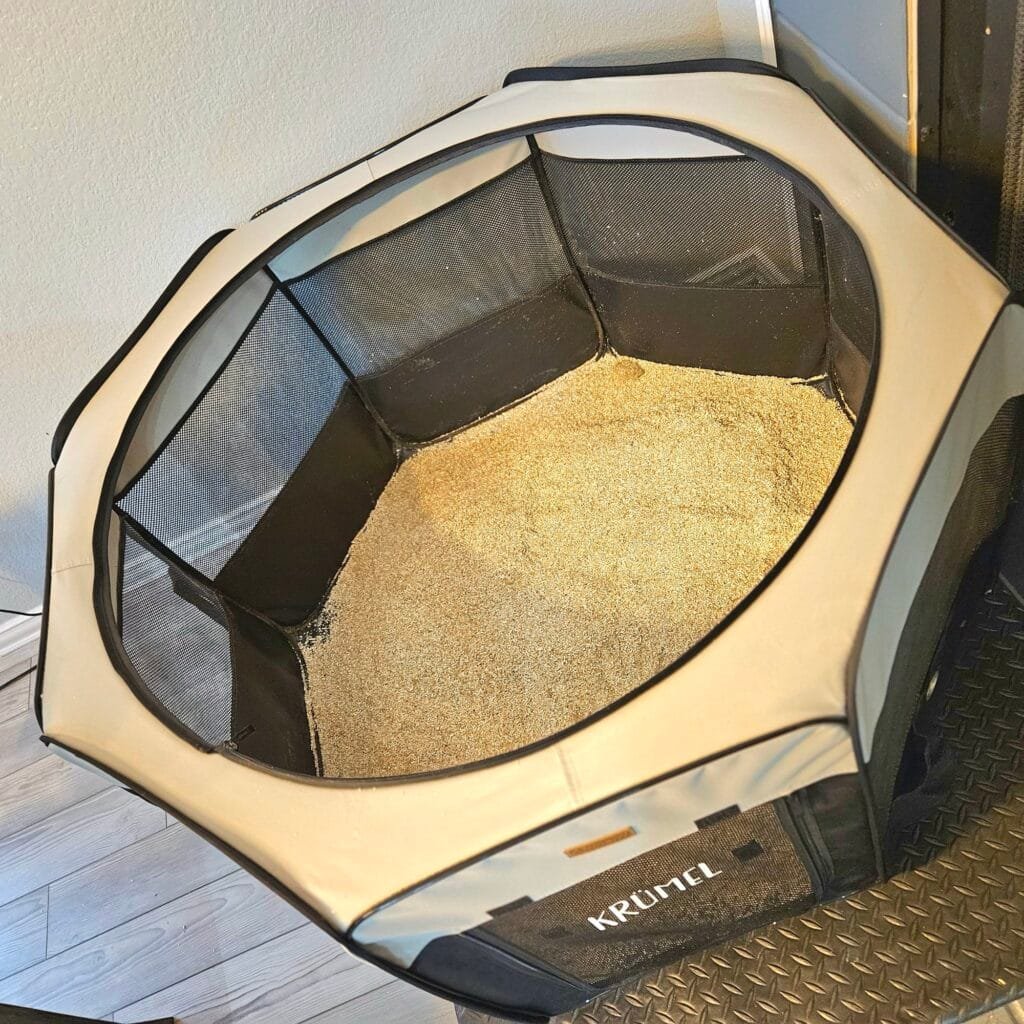
Best Practices for Using Hemp as Bedding
If you’re considering hemp bedding for your ducks, here are some tips to get the most out of it:
- Use a Thick Layer:
- When using hemp, spread a thick layer—at least 3 to 4 inches deep. This allows the bedding to absorb moisture efficiently and provide a comfortable cushion for your ducks. If you’re using hemp in nesting areas, consider adding even more for added softness and insulation.
- Spot Clean Regularly:
- While hemp bedding lasts longer than other materials, it’s still important to spot-clean regularly. Remove wet or soiled areas as needed to prevent dampness from spreading. Spot cleaning helps extend the life of the bedding and keeps the duck house drier for longer periods.
- Provide Adequate Ventilation:
- Even with hemp’s superior odor control, it’s essential to maintain good ventilation in your duck house. This prevents excess moisture and humidity from building up, ensuring a healthy environment for your ducks. Ventilation will also help keep the bedding dry and further reduce odors.
- Keep Water Outside When Possible:
- To maximize the longevity of hemp bedding, keep your ducks’ water sources outside of their house or in an elevated position. This will help prevent splashes from reaching the bedding and creating a wet, messy environment. Ducks love to play in water, so controlling the splashing will reduce the frequency of bedding changes.
- Consider Mixing with Other Materials:
- Some duck owners mix hemp bedding with other materials like pine shavings or straw to create a blend that combines the best properties of both. For example, mixing hemp with pine shavings could provide extra odor control, while adding straw could offer more bulk in larger spaces. This method can also help reduce costs while still taking advantage of hemp’s benefits.
- Ideal for Use with the Deep Litter Method:
- Hemp bedding is particularly well-suited for the deep litter method, where you allow the bedding to build up over time and naturally compost in place. Its high absorbency and odor control make it perfect for this method, as it can handle the gradual buildup of waste without becoming overly smelly or dirty. Just make sure to turn the bedding regularly to encourage the composting process.

When Hemp is the Best Option
Hemp bedding is ideal in certain situations where its unique properties really shine:
- Wet Environments: Hemp’s superior absorbency makes it an excellent choice for duck houses where moisture is a constant challenge. It can help keep the space drier, reducing the risk of health issues associated with damp bedding.
- Indoor Duck Houses: If your ducks are housed indoors or in enclosed spaces, hemp’s excellent odor control and low dust properties make it a fantastic option.
- Environmentally Conscious Duck Owners: For those who prioritize sustainability, hemp is an eco-friendly option that aligns with reducing environmental impact.
Discover the Benefits of Hemp Bedding!
As an ambassador for Grubbly Farms, I’m excited to recommend their premium hemp bedding for your ducks!
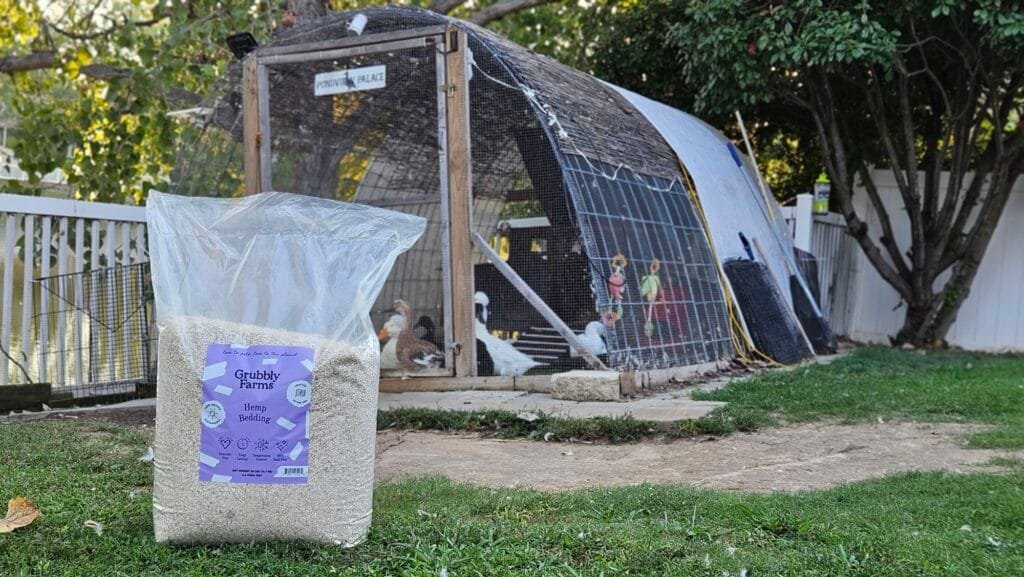
Why Choose Hemp Bedding?
- Exceptional Absorbency: Keeps your duck house dry and comfortable.
- Natural Odor Control: Neutralizes smells for a fresher environment.
- Eco-Friendly: Biodegradable and chemical-free, good for the planet.
- Soft and Comfortable: Creates a cozy resting area for your ducks.
- Easy Maintenance: Lightweight and simple to clean.
Upgrade your duck care routine with Grubbly Farms’ hemp bedding today! Your ducks will love it, and you’ll enjoy a cleaner, more sustainable living space. Visit Grubbly Farms now to order! (New customers get 30%off their first order).
Final Thoughts on Hemp as Duck Bedding
Hemp bedding is a fantastic choice for duck owners looking for a highly absorbent, low-dust, and eco-friendly option. Its ability to control moisture and odors is unmatched, making it especially useful in environments where ducks are prone to making a mess with water. However, its higher cost and limited availability can be drawbacks for some duck keepers, especially with larger flocks. If you’re willing to invest in hemp, it can save time and effort in terms of maintenance while providing a comfortable, clean environment for your ducks.
Have you tried using hemp bedding before? If not, is it something you’re considering, especially if you deal with wet or messy conditions in your duck house? Let me know your thoughts—I’d love to hear what works best for you and your flock!
Pellet Bedding For Ducks
Pellet bedding is another option that’s gaining popularity among duck keepers, especially for those seeking a clean, low-maintenance, and highly absorbent material. It’s often made from compressed wood fibers, but there are also versions made from straw or other plant materials. While pellet bedding is traditionally used for horses, it has several advantages for duck bedding as well. Let’s dive into the details of pellet bedding, discussing its benefits, drawbacks, and best practices for use.
What Is Pellet Bedding?
Pellet bedding typically comes in the form of small, dense, compressed pellets made from materials like softwood (pine, fir), hardwood, straw, or recycled paper. When moisture hits the pellets, they expand and break down into a soft, fluffy material that absorbs moisture effectively. Because the pellets are highly compressed, they are much more absorbent than loose shavings or straw, making them an ideal bedding option for areas prone to wetness.
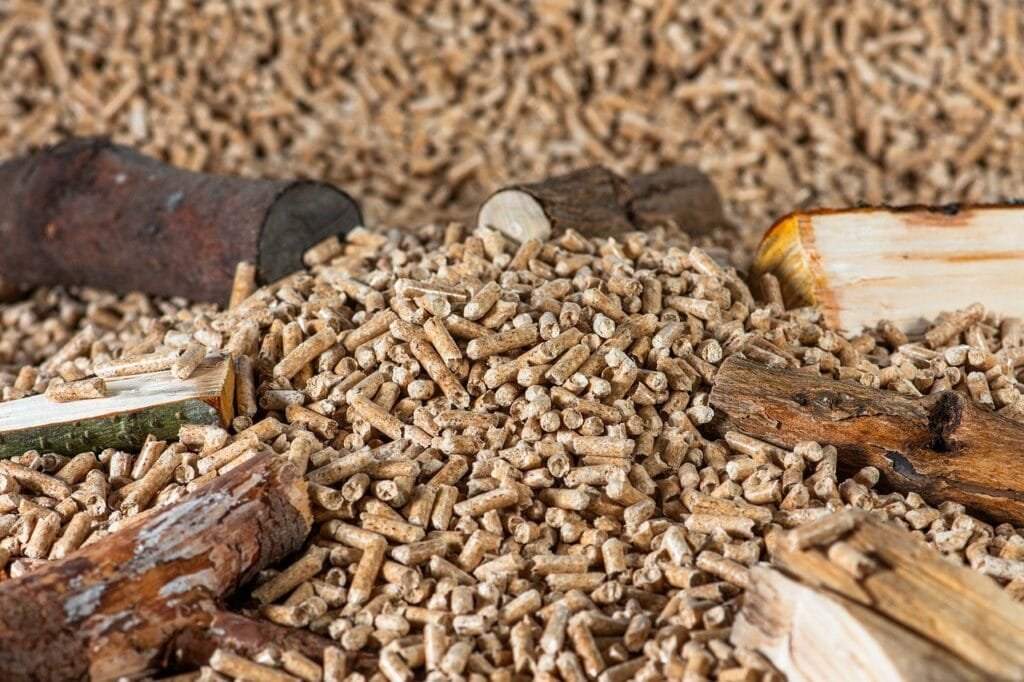
Pros of Using Pellet Bedding for Ducks
- Highly Absorbent:
- Pellet bedding is incredibly absorbent, making it an excellent choice for ducks, which tend to make their bedding wet through splashing and droppings. The pellets can absorb several times their weight in moisture, meaning you won’t have to change bedding as frequently. This helps keep the duck house drier and cleaner.
- Good Odor Control:
- Due to their high absorbency, pellets do a great job at controlling odors. The pellets trap moisture and odors inside as they expand and break down, helping to reduce the ammonia smell from duck waste. This is especially helpful if your duck house has limited ventilation or is kept indoors.
- Low Dust:
- Pellet bedding generally produces very little dust, which is an important consideration for both ducks and their keepers. Ducks are sensitive to respiratory issues, and using low-dust bedding can help reduce the risk of respiratory infections. For you, it means a cleaner environment when cleaning out the duck house.
- Long-Lasting:
- Pellet bedding has great longevity compared to traditional bedding materials like straw or shavings. Since pellets expand when they get wet, they can last longer before needing to be fully replaced. In many cases, spot cleaning of soiled areas is enough to keep the bedding fresh for weeks at a time.
- Compressed, Efficient Storage:
- One of the major perks of pellet bedding is how compact it is before use. Since the pellets are compressed, a small bag of pellet bedding will go a long way once the pellets expand with moisture. This makes it easier to store large amounts of bedding without taking up too much space.
- Easy to Clean:
- Once the pellets have broken down into their softer, expanded form, they’re relatively easy to spot clean and rake. This makes maintenance simple, as you can quickly remove soiled areas and refresh the bedding without needing to replace the entire setup frequently.
- Biodegradable:
- Pellet bedding is fully biodegradable, breaking down into compost material that can be used in your garden or compost pile. Whether you choose wood or straw pellets, they contribute organic matter back into the soil when disposed of, making them an environmentally friendly option.
- Available in Different Varieties:
- Pellet bedding comes in different materials, including softwood, hardwood, straw, and recycled paper. This gives you flexibility depending on your preference or the specific needs of your ducks. For instance, softwood pellets like pine tend to be more fragrant, while straw pellets offer a completely natural, plant-based option.
Cons of Using Pellet Bedding for Ducks
- Price:
- While not the most expensive bedding option, pellet bedding can be pricier than traditional straw or shavings, especially when using high-quality wood pellets. However, the cost is often offset by its longevity and reduced need for frequent replacements.
- Hard Texture When Dry:
- Pellet bedding starts off quite hard and compact. While this doesn’t bother larger animals like horses, it could be uncomfortable for ducks to walk or rest on until the pellets soften. Ducks have more sensitive feet, and while pellets will eventually break down into a softer form, they may need a little water added at the start to help this process along.
- Requires Some Management:
- You may need to add water to the pellets when initially setting up the bedding to ensure they expand and soften enough for your ducks’ comfort. Without some moisture, the pellets remain hard and may not offer enough cushion for resting ducks. This adds an extra step in bedding preparation compared to materials like straw or shavings, which are ready to use as-is.
- Potential for Mold in High-Humidity Environments:
- While pellet bedding is absorbent, if the environment becomes too damp or poorly ventilated, the bedding could potentially become too wet and encourage mold growth. It’s important to monitor the humidity levels in your duck house and ensure that it stays well-ventilated to prevent moisture from getting out of control.
- Not Widely Available at Farm Stores:
- Depending on your location, pellet bedding might not be as widely available in farm or pet stores compared to more common options like pine shavings or straw. You might need to order it online, which could increase the cost and wait time for replenishing your bedding supply.
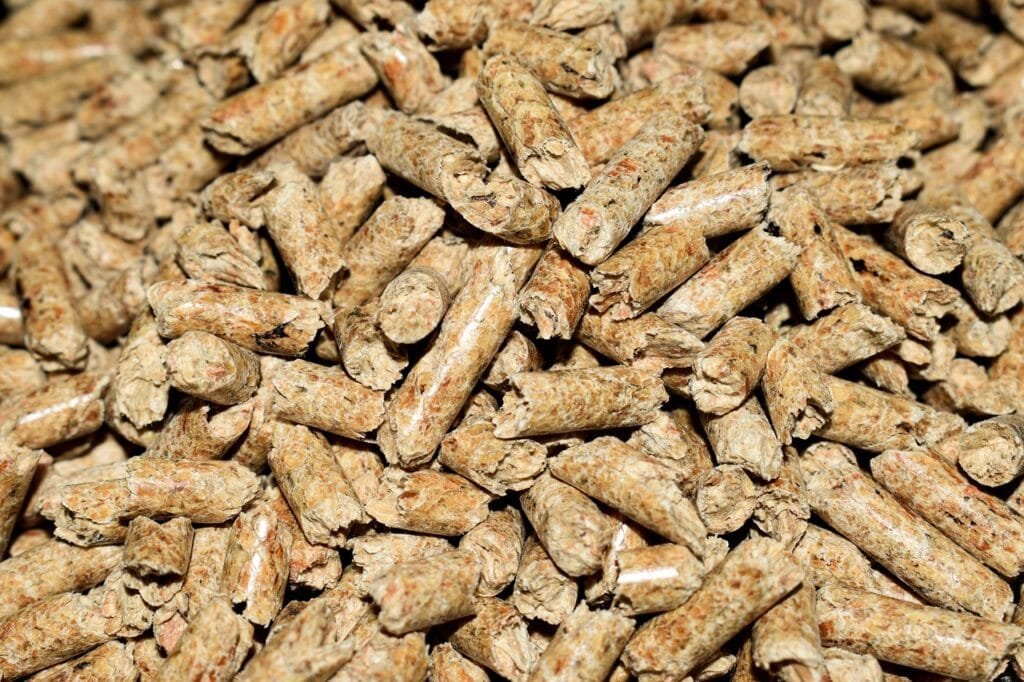
Best Practices for Using Pellet Bedding
If you decide to use pellet bedding for your ducks, here are a few tips to ensure you get the most out of it:
- Moisten the Pellets Before Use:
- To make the pellets softer and more comfortable for your ducks, it’s a good idea to lightly spray them with water when you first lay them down. This helps break down the pellets into a softer material faster. Without this step, the pellets can remain quite hard, which may not be comfortable for your ducks’ feet.
- Use a Thick Layer:
- As with other bedding types, it’s essential to use a thick layer of pellet bedding to ensure adequate absorption and comfort. Aim for at least 3 to 4 inches deep. This will provide enough material to soak up moisture effectively and give your ducks a soft area to rest on.
- Spot Clean Regularly:
- One of the great things about pellet bedding is how easy it is to spot clean. Remove any heavily soiled or wet areas daily or as needed, and rake over the remaining bedding to redistribute it. This will help extend the life of the bedding and reduce the need for frequent, complete changes.
- Monitor for Mold:
- In environments where moisture is a constant issue, such as duck houses that don’t have proper drainage or ventilation, pellet bedding can become overly saturated. Keep an eye out for any signs of mold and ensure your duck house is well-ventilated. If needed, refresh or replace the bedding before it becomes too wet.
- Mix with Other Bedding Types:
- Some duck keepers choose to mix pellet bedding with other materials like pine shavings or straw. This can provide a balance of softness and absorbency while reducing the overall cost. For instance, using a layer of pine shavings on top of pellet bedding can provide a comfortable resting surface while still taking advantage of the pellets’ superior moisture control.
- Deep Litter Method Compatible:
- Like hemp and pine shavings, pellet bedding works well with the deep litter method. Its high absorbency and odor control make it perfect for allowing the bedding to build up over time and naturally compost in place. Just remember to turn the bedding regularly and keep the moisture levels balanced.
When Pellet Bedding is the Best Option
Pellet bedding is especially useful in the following situations:
- Ducks with Wet or Messy Environments: If you have a particularly wet or messy duck house due to splashing water or high humidity, pellet bedding can help manage moisture much better than straw or shavings.
- Duck Owners Seeking Low Maintenance: If you want bedding that lasts longer between cleanings, pellet bedding’s absorbency and ease of spot cleaning make it a great low-maintenance option.
- Space-Conscious Keepers: If you have limited storage space, pellet bedding’s compressed form makes it ideal for those who need to store larger quantities of bedding in smaller spaces.
Final Thoughts on Pellet Bedding for Ducks
Pellet bedding is a fantastic choice for duck owners looking for a highly absorbent, long-lasting option that controls moisture and odors effectively. Its compact form and ease of use make it an efficient solution, though it does come with some drawbacks, such as the initial hardness of the pellets and potential cost. If you’re willing to manage its slight learning curve, pellet bedding can provide a clean, dry, and odor-free environment for your ducks with minimal effort.
Have you tried using pellet bedding with your flock? How does it compare to other bedding types you’ve used? I’d love to hear your experiences!
Bedding that is not Recommended for Ducks
When it comes to choosing bedding for your ducks, not all materials are created equal. While some may seem like a good idea at first glance, they can pose health risks or create an unsuitable environment for your feathered friends. Let’s explore the types of bedding that are not recommended for ducks, along with the reasons why they should be avoided.
1. Cedar Shavings
Cedar shavings might seem like a great option because of their pleasant smell and natural pest-repelling properties, but they are not safe for ducks or most other birds.
Why Cedar Shavings Are Not Recommended:
- Respiratory Issues: Cedar contains phenols, aromatic oils that give it that distinct cedar smell. These phenols can be highly irritating to a duck’s sensitive respiratory system. Prolonged exposure can lead to respiratory distress, coughing, sneezing, and even more serious conditions like respiratory infections.
- Toxicity: Cedar shavings can also be toxic to ducks, especially when they spend long periods in an enclosed space with them. The natural oils released by cedar can cause irritation of the eyes, skin, and mucous membranes. In extreme cases, it can lead to organ damage.
- Dust: Cedar shavings are often dustier than alternatives like pine or aspen shavings, increasing the likelihood of respiratory issues.
Better Alternative: If you’re looking for a similar wood-based bedding option, pine or aspen shavings are much safer.
2. Leaves
Using fallen leaves as bedding might seem like a natural and eco-friendly option, especially in the fall when they’re readily available. However, leaves are generally not recommended for bedding in duck houses.
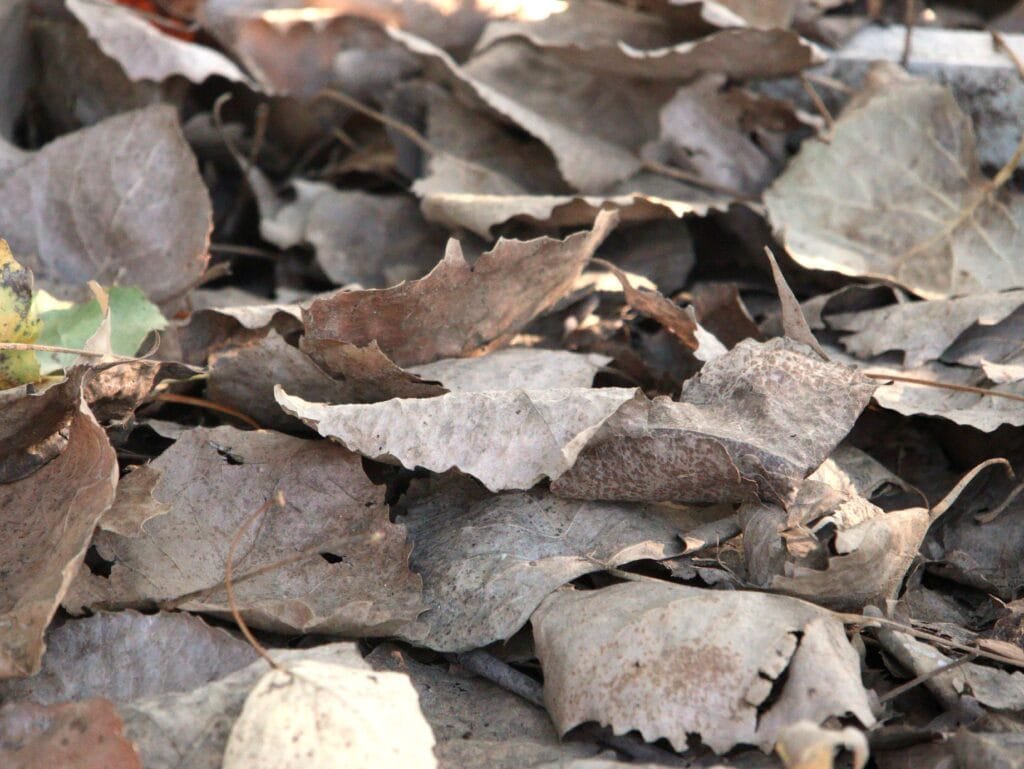
Why Leaves Are Not Recommended:
- Poor Absorbency: Leaves are not very absorbent. Ducks are notoriously messy, especially around water, and leaves quickly become soggy and slippery, creating an uncomfortable and unsanitary environment.
- Mold and Mildew: When leaves get wet, they tend to mold quickly. Moldy bedding can cause respiratory issues in ducks and create an unhealthy living space. Mold also attracts pests like flies and other insects.
- Compaction: Leaves can easily compact down into a dense, matted layer, making it difficult for moisture to escape. This creates the perfect breeding ground for bacteria and fungi.
- Decay and Smell: Wet, decaying leaves can lead to unpleasant smells in the duck house and attract unwanted pests.
Better Alternative: If you like the idea of natural bedding, consider straw, pine shavings, or even hemp, all of which are better suited to absorb moisture and stay cleaner for longer.
3. Newspaper or Paper Bedding
Some duck owners might think shredded paper or newspaper is a good choice, especially since it’s easily accessible and cheap. However, paper bedding comes with several significant downsides that make it unsuitable for ducks.
Why Paper Bedding Is Not Recommended:
- Poor Absorption: Shredded paper or newspaper does not absorb moisture well, which is a huge problem in a duck house where water splashing and wet droppings are constant. Wet paper becomes soggy and uncomfortable very quickly.
- Mats Down Easily: Paper tends to mat down, becoming a slick, slippery surface that can cause ducks to slip and injure themselves. The matted bedding also traps moisture underneath, creating a breeding ground for bacteria.
- Ink Toxicity: Some types of newspaper ink could be toxic to ducks if ingested. Ducks are curious and might nibble on bits of paper, especially when it’s easily accessible in their bedding.
- Odor Issues: Because paper doesn’t absorb moisture well, it can quickly start to smell, leaving your duck house with a strong ammonia odor from duck waste.
Better Alternative: Hemp or pellet bedding can provide much better absorbency and are safer for your ducks.
4. Sand
Sand might seem like a great bedding option, especially for waterfowl, as it’s often used in chicken coops or aviaries. However, sand is generally not recommended for ducks, especially in indoor settings or as a primary bedding material.
Why Sand Is Not Recommended:
- Lacks Absorbency: Sand does not absorb moisture well. Ducks splash water, and their droppings are more watery compared to chickens. Sand allows moisture to pool rather than soak in, which can create muddy, unhygienic conditions.
- Heavy and Difficult to Clean: Wet sand becomes heavy and difficult to manage. Cleaning out sand bedding can be labor-intensive, especially when it becomes packed down or waterlogged.
- Temperature Fluctuations: Sand can get very hot in the summer and extremely cold in the winter. In cold weather, it holds onto the cold, creating an uncomfortable environment for your ducks, especially if they like to nestle down into their bedding for warmth.
- Respiratory Issues: Fine sand particles can create dust, which can lead to respiratory issues in ducks, particularly if the sand is dry and stirred up.
Better Alternative: For outdoor areas, sand can be mixed with dirt or gravel for drainage, but for indoor bedding, options like straw, pine shavings, or hemp are much better suited.
5. Sawdust
While sawdust is inexpensive and easy to obtain, it is not recommended for ducks due to its small particle size and tendency to create dust.
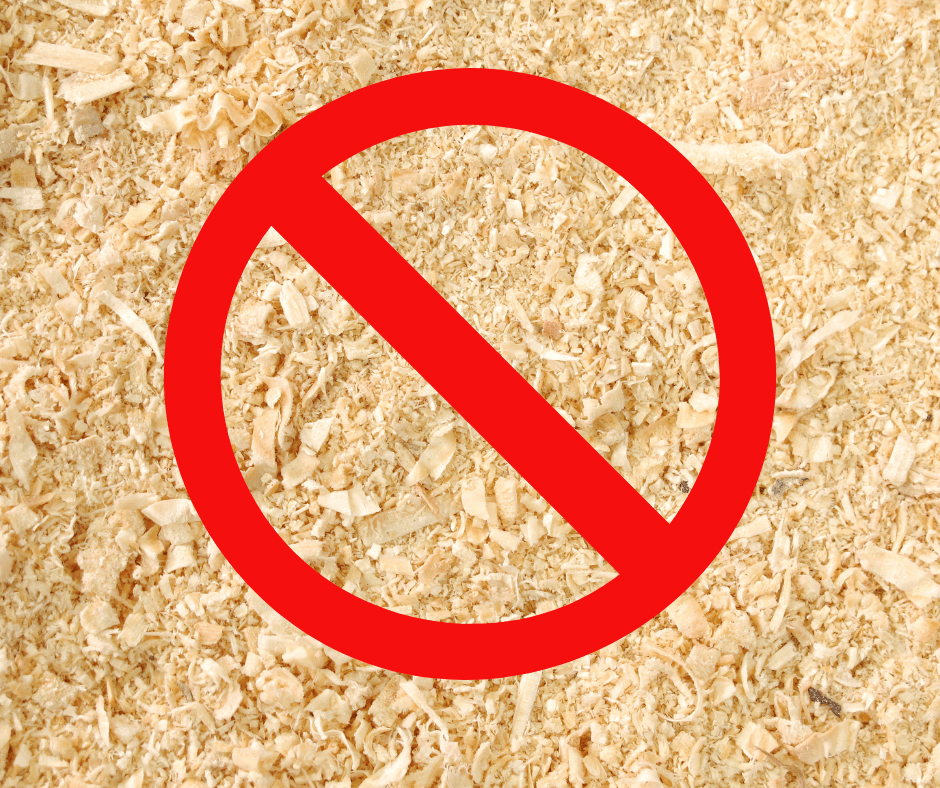
Why Sawdust Is Not Recommended:
- Excessive Dust: Sawdust can be extremely dusty, which poses a serious respiratory risk to ducks. Ducks are more sensitive to dust than some other animals, and prolonged exposure to dusty bedding can lead to respiratory issues or infections.
- Too Fine: The small particle size of sawdust can get into ducks’ eyes, noses, and mouths, causing irritation and potential health problems.
- Mats Down: Sawdust tends to mat down quickly, especially when wet, creating a dense, hard layer that doesn’t provide much cushioning or comfort for ducks to rest on. This also makes it harder to clean out when the bedding becomes soiled.
- Moisture Trapping: Although sawdust can absorb some moisture, once it becomes wet, it can trap moisture underneath, encouraging mold growth and creating a breeding ground for bacteria.
Better Alternative: Pine shavings are a better wood-based option, offering good absorbency and less dust.
Damp and moldy bedding creates the perfect environment for Aspergillus, a type of fungus that can cause aspergillosis in ducks. This respiratory disease affects the lungs and air sacs, leading to symptoms like labored breathing, weakness, and loss of appetite. Ducks are particularly vulnerable in poorly ventilated spaces with persistent moisture. To prevent this, always replace wet bedding promptly, ensure proper airflow, and use absorbent materials that dry quickly.
Summary of Bedding to Avoid
Here’s a quick recap of bedding types that are not recommended for ducks:
- Cedar Shavings: Toxic oils and dust can cause respiratory issues and irritation.
- Leaves: Poor absorbency, prone to mold, and can mat down easily.
- Paper Bedding: Poor moisture absorption, potential toxicity from ink, and mats down.
- Sand: Lacks absorbency, can become muddy, and is hard to clean and manage.
- Sawdust: Extremely dusty, too fine, and mats down when wet.
Final Thoughts
Choosing the right bedding for your ducks is an important part of maintaining their health and well-being. While it’s tempting to use readily available materials like leaves or paper, these bedding types often fall short in terms of moisture management, cleanliness, and comfort. Stick to safer, more reliable options like straw, pine shavings, hemp, or pellet bedding to ensure your ducks have a comfortable, clean, and healthy environment.
What bedding have you found works best for your flock? Share your experiences and let’s keep the conversation going on what works (and what doesn’t) in the world of duck care!





